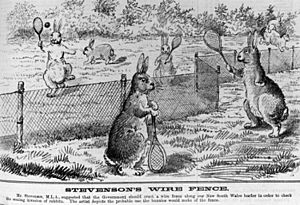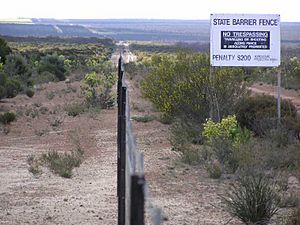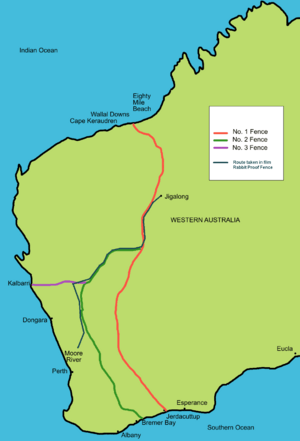Rabbit-proof fence facts for kids
The State Barrier Fence of Western Australia, formerly known as the Rabbit Proof Fence, the State Vermin Fence, and the Emu Fence, is a pest-exclusion fence constructed between 1901 and 1907 to keep rabbits and other agricultural pests, from the east, out of Western Australian pastoral areas.
There are three fences in Western Australia: the original No. 1 Fence crosses the state from north to south, No. 2 Fence is smaller and further west, and No. 3 Fence is smaller still and runs east–west. The fences took six years to build. When completed in 1907, the rabbit-proof fence (including all three fences) stretched 2,023 miles (3,256 km). The cost to build each kilometre of fence at the time was about $250 (equivalent to $18,766 in 2018).
When it was completed in 1907, the 1,139-mile (1,833 km) No. 1 Fence was the longest unbroken fence in the world.
Contents
History
Rabbits were introduced to Australia by the First Fleet in 1788, but they became a problem after October 1859, when Thomas Austin released 24 wild rabbits from England for hunting purposes, believing "The introduction of a few rabbits could do little harm and might provide a touch of home, in addition to a spot of hunting."
The rabbits proved to be extremely prolific and spread rapidly across the southern parts of the country. Australia had ideal conditions for an explosion in the rabbit population, including the fact that they had virtually no local predators.
By 1887, losses from rabbit damage compelled the New South Wales Government to offer a £25,000 reward (equivalent to $1,900,000 in 2018) for "any method of success not previously known in the Colony for the effectual extermination of rabbits". A Royal Commission was held in 1901 to investigate the situation.
Construction
The fence posts are placed 12 ft (3.7 m) apart and have a minimum diameter of 4 in (100 mm). There were initially three wires of 12+1⁄2 gauge, strung 4 in (102 mm), 1 ft 8 in (0.5 m), and 3 ft (0.9 m) above ground, with a barbed wire added later at 3 ft 4 in (1.02 m) and a plain wire at 3 ft 7 in (1.1 m), to make the fence a barrier for dingoes and foxes as well. Wire netting, extending 6 in (150 mm) below ground, was attached to the wire.
The fence was constructed with a variety of materials, according to the local climate and availability of wood. At first, fence posts were made from salmon gum and gimlet, but they attracted termites (locally known as white ants) and had to be replaced. Split white gum was one of the best types of wood used in the fence. Other timbers used were mulga, wodjil, native pine, and tea-tree, depending on what could be found close to where the fence was to be built. Iron posts were used where there was no wood. Most materials had to be hauled hundreds of kilometres from rail heads and ports by bullock, mule and camel teams.
From 1901, the fence was constructed by private contractors, but in 1904, the project became the responsibility of the Public Works Department of Western Australia, under the supervision of Richard John Anketell. With a workforce of 120 men, 350 camels, 210 horses and 41 donkeys, Anketell was responsible for the construction of the greater part of No. 1 Fence and the survey of its last 70 miles (110 km).
Maintenance
Alexander Crawford took over the maintenance of the fence from Anketell as each section was finished and remained in charge until he retired in 1922. The area inside the fence to the west became known as "Crawford's Paddock". The fence was maintained at first by boundary riders riding bicycles and later by riders astride camels. However, fence inspection was difficult from atop the tall animal. In 1910, a car was bought for fence inspection, but it was subject to punctured tyres. It was found the best way to inspect the fence was using buckboard buggies, pulled by two camels.
The camels were used as pack animals, especially in the north, while in the south, camels were used to pull drays with supplies for the riders. Camels were ideal for this as they could go for a long time without water, and it has been suggested that the fence could not have been built or maintained without the use of camels.
In addition to Crawford, there were four sub-inspectors, each responsible for about 500 miles (800 km) of fence, and 25 boundary riders who regularly patrolled 100-mile (160 km) sections of fence. Due to frontier violence in the north of the state, a 300-mile (480 km) section of No. 1 Fence was patrolled by riders in pairs.
Crawford was responsible for eliminating rabbits which had breached the fence. In the first year following the fences' completion, rabbit colonies were found and killed at several locations inside the fence, including sites near Coorow, Mullewa, and Northampton.
Following the introduction of myxomatosis to control rabbits in the 1950s, the importance of the rabbit-proof fence diminished.
Intersection with railway system
No. 1 Fence intersected railway lines at:
- Eastern Railway near Burracoppin
- Wyalkatchem: Southern Cross railway at Campion
- Sandstone Branch Railway: just west of Anketell
- Meekatharra – Wiluna railway: at Paroo
No. 2 Fence intersected with most of the Wheatbelt railway lines of Western Australia.
Elsewhere in Australia

"Mr Stevenson, M.L.A., suggested that the Government should erect a wire fence along our New South Wales border in order to check the coming invasion of rabbits. The artist depicts the probable use the bunnies would make of the fence."
The Darling Downs-Moreton Rabbit Board fence is a rabbit fence that extends along part of the Queensland-New South Wales border.
See also
 In Spanish: Barrera a prueba de conejos de Australia para niños
In Spanish: Barrera a prueba de conejos de Australia para niños




